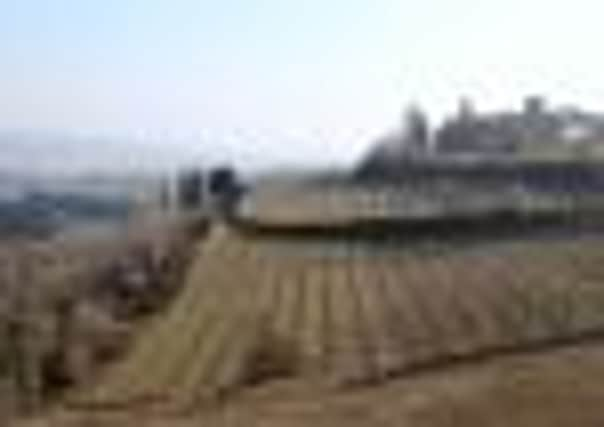Wine tasting: Reward for being patient


There are still grapes from 2010 harvest still waiting to be fermented in the part of Italy I have visited last week.
In the hills above Verona, in the heart of the Valpolicella region, there are warehouses full of grapes, stacked up in trays, drying out and shrivelling. They are making one of Italy’s flagship wines; Amarone della Valpolicella.
Advertisement
Hide AdAdvertisement
Hide AdAmarone is made from dried grapes, a method dating from Roman times or even before. It’s particularly suited to drinking on cold winter evenings where its rich, cherry fruit and dark, almost chocolately tones combine perfectly with well-flavoured meat and game dishes. The name hints at the slight bitter edge (amaro) which comes from the local grapes.
The Valpolicella name was devalued decades ago by overproduction of low-quality wine. But things have changed. There are new regulations about which grapes may be used and in what proportion – Corvina is the main grape. The old varieties are used in tiny amounts at present while they are being evaluated. To reduce yields, many producers have switched from training their grapes on pergola systems to lower yielding spur pruned systems, and the vines are going back on the steepest slopes of the valleys to produce higher quality.
The region of Valpolicella stretches back into the hills behind Verona, spread across the valleys of Fumane, Marano, Negrar, Grezzana and Mezzane. The soils vary from the rich loam of the valley floors to almost pure white limestone on the hills. The harvest starts early, in August for some grapes, which are picked by hand and laid out in trays, then stacked up in buildings known as Frutaio. These fruit-drying warehouses have doors on the south and north facing sides, so air can blow through the building, and so dry the grapes. Heat is never used since this would cook the grapes rather than dry them.
Grapes for Valpolicella are picked and fermented in the normal way, making a light, cherry-fruity wine, vastly improved from the bad days of over-production. Valpolicella Classico Superiore comes from the heartland of the region, often made using a ripasso method which involves adding some partially dried grapes towards the end of fermentation. This gives a kick-start to complete the fermentation and results in a more concentrated, complex wine. Amarone is made from grapes which have been dried for several months, so they have lost at least 30 per cent of their weight and have become shrivelled. They ferment slowly to give a deep-flavoured dry wine which is aged in barriques or larger vats for at least two years. The alcohol level of Amarone is high, with a minimum of 14 per cent but can go up to a tongue-numbing 16.5 per cent in some wines, but all Amarones keep well for several years, developing complexity and silkiness with time.
Advertisement
Hide AdAdvertisement
Hide AdRecioto is also made from dried grapes but fermentation is stopped while natural sugar remains in the wine. This makes a fabulous sweet red, which seems to have been specially made to go with chocolate desserts. Its name comes from the Italian word for ear because only the ripest top parts of the bunch, “the ears” are used for this wine.
I spent three days tasting through the newly released Amarone wines and visiting some producers. If you haven’t tasted wines from this region since a minor encounter over a bowl of spag bol, then now is the time to try them again.
My top tips are:
Valpolicella Corte Giara, Allegrini 2008, Halifax Wine Co (www.halifaxwinecompany.com) £8.95.
Top notch Valpolicella from one of the best producers in the region. No dried grapes in this – just fresh cherry fruit with smooth tannins.
Advertisement
Hide AdAdvertisement
Hide AdCapitel Niccaló Tedeschi Appassiamento 2005, Campbells of Leyburn £10.79
Made from grapes that have been dried just one month then fermented to dryness, this is a first step on the way to Amarone, still retaining fresh fruit, with a clear streak of bitter cherries on the finish.
Waitrose Ripasso di Valpolicella Classico Superiore 2008, £10.99
A real taste of the region with deep red cherry fruit and a touch of raisiny complexity.
Advertisement
Hide AdAdvertisement
Hide AdAmarone della Valpolicella Classico, Tedeschi 2006, (Halifax Wine Co) £27.50
A delicious wine that still maintains its fresh fruity style while clearly showing the typical herbal notes and savoury concentration of Amarone. A wine to put alongside a rich flavoursome casserole.
Amarone Classico La Marega, La Salette 2006, Field and Fawcett (01904 489073) £34.75
Intense black cherry fruit with cinnamon, coffee and savoury balsamic notes and smooth, silky tannins ending on a dry flavoursome raisiny note.
Advertisement
Hide AdAdvertisement
Hide AdAmarone Della Valpolicella Classico Allegrini, Harrogate Fine Wine (01423 522270), £51.99
An intensely concentrated wine, with dark, dried plummy fruit, figs, chocolate and balsamic notes wrapped around with smooth, silky tannins. For special occasions only.
Recioto Cantina Negrar 2006, Field and Fawcett £14.70 for 50cl.
The perfect accompaniment to a rich chocolate pudding, not over sweet, but full of chocolate and cherry flavours, with a long, fresh finish.